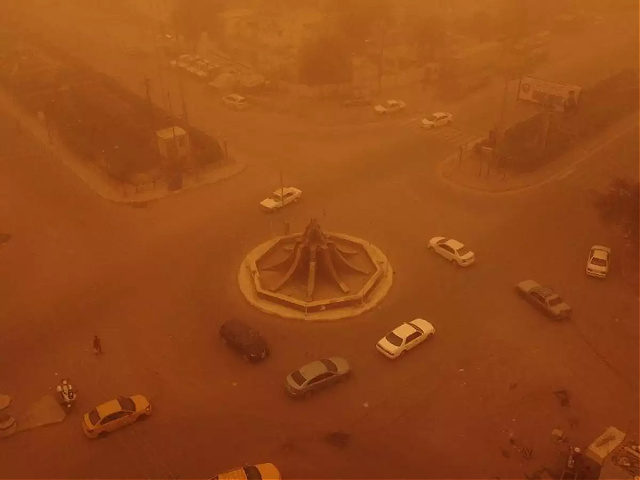A massive sandstorm blew through Iraq on Monday, forcing daily life to shut down in Baghdad and causing breathing difficulties in at least 4,000 people who sought medical treatment in hospitals nationwide, Agence France-Presse (AFP) reported.
“At least 4,000 people were admitted to hospital needing treatment for respiratory difficulties,” Iraq’s Health Ministry spokesman, Seif al-Badr, told AFP on May 16.
AFP correspondents across Iraq reported thick layers of orange dust covering buildings, and entering some, across the country’s cities on Monday, including central Baghdad (the national capital), southern Najaf (a Shiite shrine city), and northern Sulaimaniyah (in the Kurdistan Region).
Iraq’s federal government ordered all state-run offices and schools across Baghdad to shutter their doors on May 16. Baghdad International Airport closed its airspace and grounded all flights on Monday due to low visibility in the area, which was reportedly “just a few hundred feet,” according to Reuters. Outside of Baghdad, six additional provinces ordered their public businesses to shut down on Monday as well.
Iraq’s May 16 sandstorm was its eighth such storm since mid-April. A previous dust storm in Iraq on May 5 caused one death and hospitalized at least 5,000 people seeking treatment for respiratory illness.
Iraq’s Meteorological Authority said in early May the country was “under a North African depression, known locally as ‘khamaseen.'” This regular weather event is an established natural phenomenon that affects sections of Western Asia in the spring, including Iraq. The period of low air pressure typically lasts for about 50 consecutive days. The word khamaseen means “fifties” in Arabic and refers to the wind storm’s average duration.
“The Middle East has always been battered by dust and sandstorms, but they have become more frequent and intense in recent years,” AFP noted on Monday.
“The trend has been associated with overuse of river water, more dams, overgrazing and deforestation,” according to the news agency.
“In April, an environment ministry official warned that Iraq could face ‘272 days of dust’ a year over the next two decades,” AFP noted.
Iraq’s Environment Ministry said at the time the effects of yearly khamaseens could be cushioned by “increasing vegetation cover and creating forests that act as windbreaks.”
Fine dust particles can cause various health complications including asthma and cardiovascular ailments. Strong winds associated with dust storms often stir up bacteria, viruses, pesticides, and other toxins that may already be present in an affected environment, causing harm to those who inhale the substances.

COMMENTS
Please let us know if you're having issues with commenting.